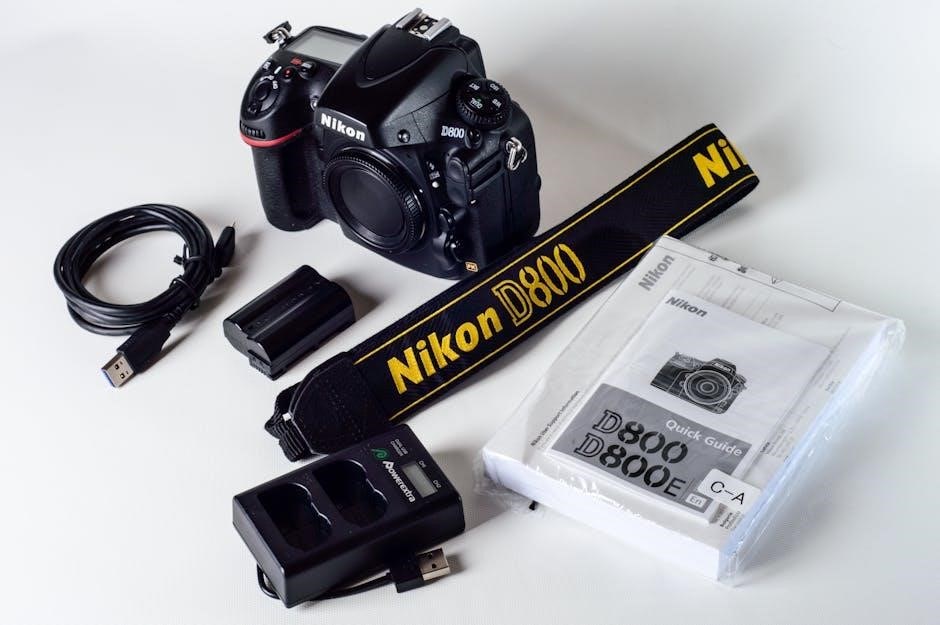Functional Skills Maths Level 2 practice tests are essential for exam preparation, offering a realistic assessment experience. These resources, available as free PDFs, cover various topics and question types, helping learners improve problem-solving skills and confidence; Widely available from exam boards like Edexcel and OCR, as well as educational websites, they provide valuable insights into exam format and requirements, ensuring comprehensive preparation for success.
Overview of Functional Skills Maths Level 2
Functional Skills Maths Level 2 is a qualification that equips learners with essential mathematical skills for everyday life and employment. It is designed to assess problem-solving abilities, covering topics like number, measurement, shape, space, and data handling. The exam is divided into two sections: one without a calculator (30 minutes, 15 marks) and another with a calculator (45 minutes, 45 marks). The total marks available are 60, and learners need to demonstrate accurate calculations and practical application of mathematical concepts. Achieving this qualification is equivalent to a GCSE Grade 4-5 and is recognized by employers and educational institutions as a key skill for progression. Regular practice with past papers and online resources is highly recommended to build confidence and understanding of the exam format.
Importance of Practice Tests for Level 2 Maths
Practice tests are a cornerstone of effective preparation for Functional Skills Maths Level 2, enabling learners to gauge their exam readiness and build confidence. These tests simulate real exam conditions, helping candidates familiarize themselves with the format, timing, and types of questions. Regular practice identifies weak areas, allowing targeted revision and improved problem-solving skills. Moreover, practice tests enhance time management and reduce exam anxiety. With free PDF resources widely available, learners can access past papers and sample assessments to refine their strategies. Consistent use of practice tests is proven to boost performance, ensuring learners are well-prepared to achieve a high score and progress in their educational or professional journey.
Structure of the Article
This article provides a comprehensive guide to free Functional Skills Maths Level 2 practice tests in PDF format. It begins with an introduction to the qualification and its significance. The next section explores the importance of practice tests for effective exam preparation. The article then outlines its structure, ensuring a logical flow of information. Subsequent sections detail sources of free practice tests, key topics covered, and the exam format. Additional resources for revision, such as workbooks and online tutorials, are also highlighted. Tips for success, including study habits and avoiding common mistakes, are provided to help learners excel. Finally, the article concludes with encouragement to utilize free resources and guidance on next steps after completing practice tests. Each section is designed to support learners in achieving exam success.

Sources of Free Functional Skills Maths Level 2 Practice Tests PDF
Free Functional Skills Maths Level 2 practice tests are available from official exam boards like Edexcel and OCR, educational websites, and open-source platforms.
Official Exam Board Resources
Official exam boards such as Edexcel and OCR provide authentic and reliable free Functional Skills Maths Level 2 practice tests in PDF format. These resources are specifically designed to match the exam format and content, ensuring learners are well-prepared. They include past papers, sample assessments, and mark schemes, offering a comprehensive understanding of the test structure and grading criteria. Available on their official websites, these materials cover essential topics like number systems, data handling, and measurement. Regularly updated, they reflect the latest syllabus requirements. Practicing with these official resources helps learners familiarize themselves with question types, time management, and exam strategies. Additionally, they offer detailed feedback, enabling learners to identify and improve their weaknesses effectively. These resources are a cornerstone of effective exam preparation.
Independent Educational Websites
Independent educational websites like Skipton Tutors and Runway Training offer a wealth of free Functional Skills Maths Level 2 practice tests in PDF format. These platforms curate resources from various sources, including past papers, sample assessments, and worksheets, to support learners. They often provide detailed solutions and mark schemes, enabling self-assessment and improvement. Many of these websites also offer additional resources, such as video tutorials and interactive tools, to complement practice tests. These independent sites are particularly useful for learners seeking flexible and accessible study materials. By utilizing these resources, learners can enhance their understanding of key topics and refine their exam techniques. They are a valuable supplement to official exam board materials.
Open-Source Learning Platforms

Open-source learning platforms provide a diverse range of free Functional Skills Maths Level 2 practice tests in PDF format. Platforms like XAMS and Literacy Skills Test offer sample assessments and practice papers that mirror real exam conditions. These resources are often community-driven, with contributions from educators and learners, ensuring a wide variety of question types and topics. Many open-source platforms also include interactive tools, such as online quizzes and progress trackers, to enhance learning. They are particularly useful for learners seeking flexible and accessible study materials. By leveraging these platforms, learners can gain valuable insights into exam formats and refine their problem-solving skills. These resources are a great supplement to traditional study materials and official exam board content.

Key Topics Covered in Functional Skills Maths Level 2
Functional Skills Maths Level 2 covers essential topics like number systems, measurements, shape, space, and handling data, providing a solid foundation for real-world problem-solving skills.
Number and the Number System
Functional Skills Maths Level 2 focuses on the number system, covering fractions, decimals, percentages, and ratios. Practice tests include operations like addition, subtraction, multiplication, and division with whole numbers and decimals. Students also explore negative numbers, rounding, and estimating. These skills are applied to real-world scenarios, such as budgeting, financial decisions, and measuring quantities. Understanding number systems is crucial for problem-solving in everyday life and career environments, ensuring learners can manipulate and interpret numerical data confidently and accurately.
Measurements, Shape, and Space
Functional Skills Maths Level 2 includes measurements, shape, and space, focusing on practical applications. Topics cover calculating perimeter, area, and volume, as well as understanding properties of 2D and 3D shapes. Students learn to interpret scales, convert units, and apply geometric principles to real-world problems. These skills are vital for tasks like budgeting for materials, designing spaces, or calculating distances. Practice tests often include scenarios involving construction, DIY projects, or navigation, helping learners develop spatial reasoning and measurement accuracy. Mastery of these concepts enhances problem-solving abilities in various career and everyday situations, ensuring confidence in handling mathematical challenges effectively.
Handling data is a core component of Functional Skills Maths Level 2, focusing on interpreting, analyzing, and presenting information. Students learn to work with charts, graphs, and tables, calculating averages, ratios, and probabilities. Practice tests include real-life scenarios, such as budgeting, statistics, and trend analysis, to enhance understanding. Free PDF resources from Edexcel and OCR provide exercises on filtering, sorting, and interpreting data, ensuring learners can apply these skills confidently. These exercises are designed to mirror real-world applications, helping students develop the ability to make informed decisions and solve problems effectively. Regular practice with these materials is key to mastering data handling and achieving success in the exam.

Structure of Functional Skills Maths Level 2 Practice Tests
Handling Data
Handling data is a core component of Functional Skills Maths Level 2, focusing on interpreting, analyzing, and presenting information. Students learn to work with charts, graphs, and tables, calculating averages, ratios, and probabilities. Practice tests include real-life scenarios, such as budgeting, statistics, and trend analysis, to enhance understanding. Free PDF resources from Edexcel and OCR provide exercises on filtering, sorting, and interpreting data, ensuring learners can apply these skills confidently. These exercises are designed to mirror real-world applications, helping students develop the ability to make informed decisions and solve problems effectively. Regular practice with these materials is key to mastering data handling and achieving success in the exam.
Assessment Format and Timing
Functional Skills Maths Level 2 practice tests typically consist of two sections: non-calculator and calculator-allowed parts. The total duration ranges from 1 hour 30 minutes to 2 hours, depending on the exam board. Questions cover a range of topics, including number, measurement, shape, space, and data handling. Free PDF resources, such as those from Edexcel and OCR, provide clear instructions and timings, mirroring real exam conditions. Candidates are advised to allocate time wisely, ensuring they complete both sections within the allocated period. Practice tests often include answer sheets or mark schemes for self-assessment, helping learners identify areas for improvement. Regularly timed practice enhances time management skills, a critical factor for success in the actual exam.
Types of Questions and Their Weightage
Functional Skills Maths Level 2 practice tests include a variety of question types, such as multiple-choice, short-answer, and open-response questions. These are designed to assess skills like problem-solving, data interpretation, and real-world application. The tests typically feature a mix of straightforward calculations and more complex, multi-step problems. Non-calculator sections focus on basic arithmetic and mental maths, while calculator-allowed sections include more advanced topics like percentages, ratios, and algebra. The weightage of questions varies, with a higher emphasis on practical applications and data handling. Free PDF resources, such as those from Edexcel and OCR, provide examples of these question types, helping learners understand the exam format and focus their revision effectively.

Mark Scheme and Grading Criteria
The mark scheme for Functional Skills Maths Level 2 provides a detailed breakdown of how marks are allocated for each question. Grading criteria focus on accuracy, mathematical methods, and the ability to interpret results. Practice tests include sample answers and explanations, ensuring learners understand what constitutes a correct response. Marks are allocated based on the complexity and difficulty of questions, with a total of 60 marks available in the exam. Free PDF resources, such as those from Edexcel and OCR, include mark schemes that highlight common errors and best practices. Understanding the grading criteria helps learners identify areas for improvement and ensures they meet the required standards for success.

Preparing for Functional Skills Maths Level 2
Understanding the syllabus and exam requirements is crucial for effective preparation. Utilize free practice tests to familiarize yourself with the format and improve problem-solving skills. Developing consistent study habits and time management strategies will enhance your readiness and confidence for the exam.
Benefits of Using Practice Tests
Practice tests offer a realistic exam experience, helping learners assess their readiness and identify areas for improvement. Regularly using free Functional Skills Maths Level 2 practice tests enhances problem-solving skills, boosts confidence, and familiarizes students with the exam format. Mock exams allow learners to practice time management and reduce anxiety, ensuring they perform optimally during the actual assessment. By reviewing answers and explanations, students gain insights into their strengths and weaknesses, enabling targeted revision. Consistent use of practice tests fosters a deeper understanding of key topics and builds resilience, ultimately leading to better exam outcomes. They are an invaluable tool for achieving success in Functional Skills Maths Level 2.
Understanding the Syllabus and Exam Requirements
Understanding the syllabus and exam requirements is crucial for effective preparation. Functional Skills Maths Level 2 focuses on practical skills in number, measurement, shape, space, and data handling. The exam is divided into two sections: a non-calculator section (15 marks) and a calculator section (45 marks), lasting 1 hour 45 minutes. Familiarizing oneself with the structure and content ensures learners focus on key areas. By reviewing past papers and practice tests, students can identify the types of questions and their weightage, allowing targeted study. Grasping the assessment format and timing is essential for effective time management and exam strategies, ultimately leading to better performance and confidence in the exam. This understanding is vital for success in Functional Skills Maths Level 2.
Time Management and Exam Strategies
Effective time management and exam strategies are vital for success in Functional Skills Maths Level 2. Allocate time wisely, spending approximately 1 minute per mark on each question. Prioritize high-weightage sections, such as data handling, to maximize scores. Practice tests help simulate exam conditions, allowing learners to refine their pacing and reduce anxiety. Reviewing mark schemes provides insights into expected answers, enabling better preparation. Employ strategies like underlining key information, breaking down complex problems, and using estimation to check reasonableness. Learning from feedback ensures improvement in weak areas. By mastering these techniques, candidates can approach the exam with confidence and achieve their full potential. Regular practice and strategic planning are key to success.

Additional Resources for Revision
Enhance your preparation with revision guides, workbooks, and online video tutorials. Utilize interactive tools and apps to reinforce learning and improve problem-solving skills effectively.
Revision Guides and Workbooks
Revision guides and workbooks are indispensable tools for preparing for Functional Skills Maths Level 2. They provide structured content, covering key topics such as number systems, measurements, and data handling. Many guides include practice exercises, worked examples, and detailed explanations to help learners understand complex concepts. For instance, Pearson’s Functional Skills Mathematics Division Practice and CGP’s 10-Minute Tests are popular resources that cater to different learning needs. These materials often align with exam syllabi, ensuring focused revision. Additionally, workbooks like Functional Skills Maths Level 2 Practice Papers offer a wide range of questions, simulating real exam scenarios. They are available as free PDF downloads, making them accessible for all learners.
Online Video Tutorials and Webinars
Online video tutorials and webinars are excellent supplementary resources for Functional Skills Maths Level 2 preparation. Platforms like Skipton Tutors and Runway Training offer free video content that covers essential topics such as number systems, measurements, and data handling. These tutorials often include step-by-step explanations, real-life examples, and interactive exercises to enhance understanding. Webinars, meanwhile, provide live or recorded sessions where experts discuss key concepts and strategies for exam success. Many of these resources are designed to complement practice tests, helping learners grasp challenging areas and improve their problem-solving skills. They are particularly useful for visual learners and those who prefer interactive learning over traditional study materials.
Interactive Maths Tools and Apps
Interactive maths tools and apps are dynamic resources that enhance learning for Functional Skills Maths Level 2. Many educational websites and platforms offer free interactive exercises, quizzes, and games tailored to exam topics. These tools provide immediate feedback, helping learners identify and correct mistakes. Apps like CGP 10-Minute Tests and online platforms with interactive question banks allow students to practice specific skills, such as handling data or solving equations, in an engaging way. Additionally, some tools include progress tracking, enabling users to monitor their improvement over time. These resources are particularly useful for self-paced learning and can be accessed anytime, making them a valuable complement to practice tests and traditional study materials.

Tips for Success in Functional Skills Maths Level 2
To succeed in Functional Skills Maths Level 2, regularly practice with free PDF tests, understand the syllabus, manage time effectively, seek feedback, and stay calm during exams.
Common Mistakes to Avoid
When preparing for Functional Skills Maths Level 2, avoid common mistakes such as poor time management, ignoring weak areas, and not reviewing errors. Many students underestimate the importance of practicing under timed conditions, leading to incomplete tests. Others fail to identify and address gaps in their knowledge, which can result in recurring errors. Additionally, misreading questions or skipping steps in calculations often leads to incorrect answers. To avoid these pitfalls, use free practice tests strategically, focus on understanding concepts rather than rushing through problems, and seek feedback to improve. Regularly reviewing mistakes and learning from them is key to achieving success in the exam;

Effective Study Habits and Routine
A well-structured study routine is crucial for success in Functional Skills Maths Level 2. Dedicate specific times daily for practice, ensuring consistency and progress. Use free practice tests to identify weak areas and focus on improving them. Incorporate timed sessions to build exam stamina and familiarize yourself with the test format. Regularly review mistakes to understand and correct them. Maintain a balanced schedule, allowing time for breaks to avoid burnout. Organize study materials, including worksheets and online resources, to streamline preparation. Consistency and discipline in your study routine will enhance understanding, boost confidence, and ensure readiness for the exam. By integrating these habits, you can effectively utilize free resources to achieve your goals.
Importance of Feedback and Review
Feedback and review are vital for improving performance in Functional Skills Maths Level 2. Utilizing free practice tests allows learners to assess their understanding and identify areas needing improvement. Reviewing answers and explanations helps clarify misconceptions and strengthens problem-solving skills. Regularly revisiting mistakes ensures long-term retention of concepts. Feedback from practice tests provides insights into exam readiness, enabling focused study on weaker topics. By reviewing and learning from errors, candidates can approach the actual exam with confidence and accuracy. Incorporating feedback into study routines fosters a deeper understanding of the material and enhances overall exam performance, making it a cornerstone of effective preparation.
Mastery of Functional Skills Maths Level 2 requires consistent practice and review. Free practice tests provide invaluable insights, helping learners achieve confidence and exam success through focused preparation.
Final Thoughts on Preparing for the Exam
Consistent practice with free Functional Skills Maths Level 2 resources is key to exam success. Regularly using practice tests helps build confidence and familiarity with the exam format. Understanding the structure, timing, and question types ensures better time management during the actual test. Focus on weak areas identified through practice and revise thoroughly. Utilize additional resources like revision guides and video tutorials to reinforce learning. Stay calm and approach each question systematically. By leveraging these strategies, learners can effectively prepare and achieve their goals in the Functional Skills Maths Level 2 exam.
Encouragement to Utilize Free Resources
Free Functional Skills Maths Level 2 practice tests are a valuable resource that can significantly enhance your exam preparation. These materials are widely available and easily accessible, offering a cost-effective way to familiarize yourself with the exam format and content. By utilizing these resources, you can identify areas for improvement, refine your problem-solving skills, and build confidence. Many websites provide comprehensive practice papers, video tutorials, and interactive tools to cater to different learning styles. Leveraging these free resources ensures you are well-prepared and can approach the exam with confidence. Don’t hesitate to explore and use these tools to maximize your potential and achieve success in your Functional Skills Maths Level 2 exam.
Next Steps After Completing the Practice Tests
After completing the practice tests, review your answers to identify strengths and areas for improvement. Focus on understanding mistakes and addressing gaps in knowledge. Use the insights gained to target specific topics and refine your problem-solving techniques. Seek feedback from tutors or peers to further enhance your understanding. Consistent practice and revision will help solidify your skills. Finally, ensure you are registered for the exam and familiar with the exam format and timing. By following these steps, you can confidently progress toward achieving success in your Functional Skills Maths Level 2 exam. Utilize additional resources like revision guides or online tutorials to reinforce your learning journey.










